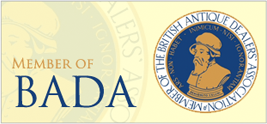| Steppes Hill Farm Antiques Newsletter #43 - March 2015 |
 |


Click on the above image to zoom
Apart from the hallmarks on English Sterling Silver, we as dealers or collectors are fortunate with some 19th and 20th century pieces to have another system of marks to aid us with dating and attributing an item. I refer to Design Registration marks introduced to allow designers and inventors to patent and protect their work. All of the original aplications and documents are now kept at the National Archives at Kew in London and are available for public viewing once one has acquired a 'Reader's Ticket'.
I find it fascinating to look at a piece of silver alongside the original Patent documents and drawings and I think it adds something to the item to be able to provide this information, which I can do here with an ingeneous revolving silver and guilloche enamel Cigarette Box made by Sampson Mordan in the early 20th century.


The Cigarette Box is marked with a full set of English hallmarks and is marked in several places but it is also stamped with the Patent Number: 281515, which of course relates to the Patent application illustrated above. It is easy to date an item via a Registered design or patent number and I will give details of how to do this below.
English Design Registration 1842-1883
The Designs Act of 1842 consolidated all earlier acts and simplified the process to register a design. It created 13 classes of ornamental design materials, including metal, which was class number I. Items whose design was registered at the Patent Office Design Registry are marked with a registration diamond or lozenge mark where the letters and figures identify the class of product, the year month and day of registration, and the parcel number. The design act protected the design for three years, although manufacturers continued to mark their wares long after the legal protection expired. The system can be divided into two periods:-
1842-1867
In the first period, the year letter is at the top, just below the material numeral, with the month on the left, day on the right, and the parcel number at the bottom. Thus the example "A" below reads 2nd June 1850.
1868-1883
The system was changed slightly in 1867 and in the second period, the year is on the right, month at the bottom, day at the top, and the parcel number on the left. Thus the second example "B" reads 7th July 1873.

Post-1883
After 1883, design registration diamond or lozenge marks were replaced with a single Registered Design Number proceeded by the letters 'Rd' beginning with number 1 in 1884 and continuing until 1989. In 1989 the beginning number in August changed to 2,000,000. (See table below).


I think it is important to keep a web site "fresh" and with this in mind I am pleased to be able to offer over 50 new items of stock this month and they include; an Edwardian Novelty Silver Camel Pin Cushion, a rare George V Antique Silver Fox Head Pocket Pencil Sharpener, a fine George III large Silver Gilt 'Shepherd Boy' Vinaigrette with a Swan Grille, an unusual George III Silver Bougie Box with engraved Hunting Scene, a pair of George III silver Powder Pots with Squirrel Crests, a George V Scottish Provincial Silver Caddy Spoon 'Balmoral Castle', a rare Victorian Silver & Enamel Lady Jockey Vesta Case, and a 'top-of-the-range' Victorian Silver & Enamel Triple Compartment Stamp Box.

Please make sure and check out the latest articles in our Blog, for all the latest news in the silver world and some other interesting features

I do hope that you will find this Newsletter informative and helpful and will allow us send it to you on a regular basis. I would welcome any feedback you may have, both positive and negative.
David W.A. Buck.
Steppes Hill Farm Antiques |
|

 |
 |
|

